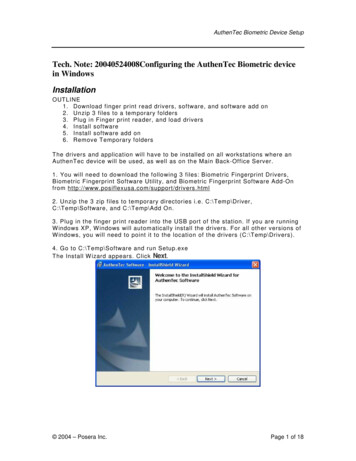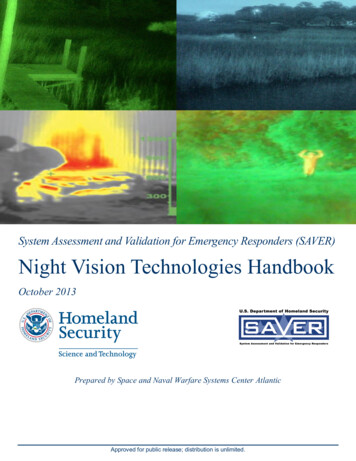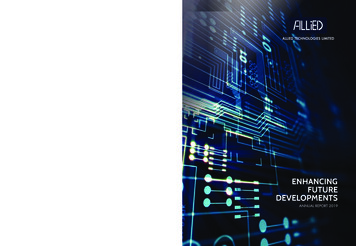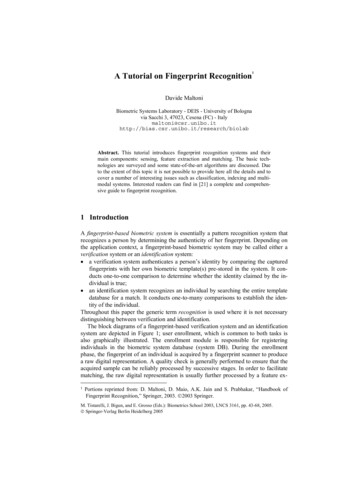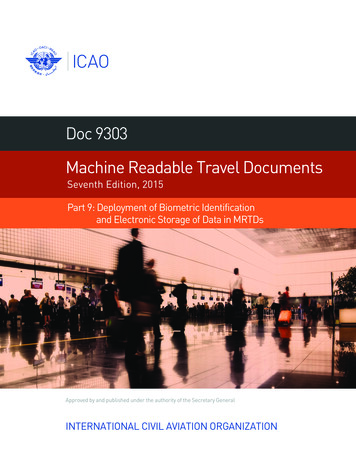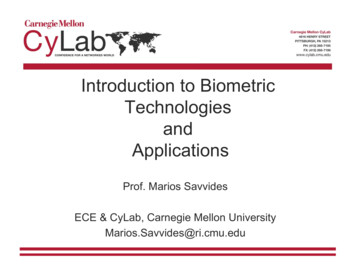
Transcription
Introduction to BiometricTechnologiesandApplicationsProf. Marios SavvidesECE & CyLab, Carnegie Mellon UniversityMarios.Savvides@ri.cmu.edu
What are Biometrics? The term "biometrics" is derived from the Greekwords bio (life) and metric (to measure). For our use, biometrics refers to technologies formeasuring and analyzing a person'sphysiological or behavioral characteristics. Thesecharacteristics are unique to individuals hencecan be used to verify or identify a person.Also Look at report by Duane M. Blackburn, Federal Bureau of etrics/biometrics 101.pdf or biometrics 101.pdf
Problems with current securitysystems Based on Passwords, or ID/Swipe cardsCan be Lost.Can be forgotten.Worse! Can be stolen and used by athief/intruder to access your data, bankaccounts, car etc .
Some statistics on User/Passwords Case Study: Telesis Community CreditUnion(CA), a California based financialservices provider that manages 1.2 billion inassets. The VP of IT, lead a team to run a networkpassword cracker as part of an enterprisesecurity audit last year to see if employeeswere following Telesis’ password policies. Result: They were far from doing so ity/story/0,10801,101557,00.html
Some statistics on User/Passwords In fact within 30 seconds the team was ableto identify 80% of people’s passwords! The team asked employees to change theirpasswords and comply with passwordpolicies. A few days later, the IT team run theirpassword cracking exercise again . This time they still were able to crack 70% ofthe passwords!
Problems with current securitysystems With increasing use of IT technology and need to protect data,we have multiple accounts/passwords.We can only remember so many passwords, so we end upusing things we know to create them (birthdays, wife/girlfriendsname, dog, cat )Its is easy to crack passwords, because most of our passwordsare weak!If we create strong passwords (that should be meaningless tous) we will forget them! And there is no way to remembermultiple such passwordsGood rules to follow when creating hentication/July2002.pdf
Many problems with currentsecurity authenticationsystems ANSWER:USE BIOMETRIC TECHNOLOGY
Some Examples of DifferentBiometrics FaceFingerprintVoicePalmprintHand GeometryIrisRetina ScanVoiceDNASignaturesGaitKeystroke
Applications Terminology Identification:– Match a person’s biometrics against adatabase to figure out his identity byfinding the closest match.– Commonly referred to as 1:N matching– ‘Criminal Watch-list’ application scenarios
Applications Terminology Verification:– The person claims to be ‘John’, system mustmatch and compare his/hers biometrics withJohn’s stored Biometrics.– If they match, then user is ‘verified’ orauthenticated that he is indeed ‘John’– Access control application scenarios.– Typically referred as 1:1 matching.
Fingerprint Matching
Minutiae based fingerprintMatching This is one of the most commonly usedalgorithms for extracting features thatcharacterizes a fingerprint. The different Minutiae feature locations andtypes can identify different individuals. These are what are stored in the Biometrictemplate. Image & Signal processing used to processfingerprint images
Fingerprint Minutiae ExtractionOriginalProcessedThinning
Fingerprint Minutiae ExtractionMinutiaeOriginalFinal Processed withFingerprint Minutiae Detected
Some example Minutiae typesprabhakar PR3465.pdfRef: Salil Prabhakar, Anil K. Jain, Sharath Pankanti: Learning fingerprint minutiae location and type. Pattern Recognition 36(8): 18471857 (2003)
Fingerprint Biometric Localfeatures Minutiae Ridgeendings Ridge bifurcationsRidge endingRidge Bifurcation Globalfeatures Ridgeorientation Pattern of ridgesLeft loopArchWhorl
NIST 24 database Class 3 – Small variation
NIST 24 database Class 10 – Large Variation
Fingerprint Compression
Why do we need compression? Wehave gigabytes of storage right? FBI has been collecting fingerprint cards since 1924!Their collection has grown to over 200 million cardsoccupying an acre of filing cabinets in the J. EdgarHoover building back in Washington! This includes some 29 million records they examineeach time they're asked to round up the usualsuspects’! Need over 2,000 Terrabytes of storage.and thisnumber is growing! 30,000-50,000 new cards perday!
Need to use Compression! Butwhat type? Lets see the issues. Look at thefingerprint core
Use JPEG compression (1:12.9)OriginalJPEG Compressed JPEG compression has too many ‘blocky’ artifacts (ituses an 8x8/16x16 transform coder).
Use Wavelet Compression!45,853 bytes45,621 bytesJPEG compressedWavelet CompressionLess compression artifacts!
Comparing Wavelet compressionto JPEG at 0.6 bppWavelet Compression @ 0.6bppJPEG compression @ 0.6bppJPEG artifacts are more noticable now!
How it works?Source: http://www.c3.lanl.gov/ brislawn/FBI/FBI.html
Example of a Complete Fingerprint compressedusing this methodOriginal FingerprintWavelet reconstructed(compressed at 0.75bpp)Source: http://www.c3.lanl.gov/ brislawn/FBI/FBI.html
Liveliness Tests Possible solutions being explored:– Measure temperature– Measure current flow (inject a smallvoltage across the fingerprint)– Use IR Led sensors to look for blood veins.
Fingerprint Sensors
Different Fingerprint Sensors Optical Sensors– Optic reflexive– Optic Transmissive– Fiber Optic Plate Capacitative/semiconductor Sensors– Static Capacitative I, II– Dynamic Capacitative Ultrasound sensors
Pros / Cons Semiconductor (capacitative) sensors areconsidered to be Low Cost. (but some areprone to ESD (Eletro-Static Discharge)problems over long term use. Optical Sensors are considered to have ahigh degree of stability and reliability. (NoESD problems), however are larger in size! Ultrasound Sensors are very precise andfraud-free but expensive to implement.
How Optical Sensors workBasic Idea Fingerprint touches the prism. It is illuminated from one sidefrom the lamp and is transmitted to the CCD camera throughthe lens using total internal reflection. s/fingerprint sensors physics.htm#thermal
Touchless (reflection) FingerprintSensors Light is reflected from thefingerprint itself onto theCMOS sensor to form thefingerprint image. s/fingerprint sensors physics.htm#thermal
Touch-less Sensors can be usedto provide a surround fingerprint Surround Fingerprint iscapturedhttp://www.tbsinc.com/products/finger sensor/index.php
Capacitative Sensors These sensors measure the capacitance between the skin andthe sensor to acquire fingerprints. Ridge and valleys of a fingerprint have different capacitancewhich provide a signature to output a fingerprint image. These sensors are typically very cheap but are prone to damageby electro-static discharge (ESD).
RF Field Fingerprint Sensors A low radio frequency (RF) signal is injected into thefinger, then read by the sensor array on silicon whichact like receiver antennas. The signal strength at each antenna (or pixel)depends on the distance between the skin at thatpoint and the sensor. This is how the image of thefingerprint is produced.
Companies with RF modulationsensing Authentec:http://www.authentec.com/ Fingerprint D 2 Idex:http://www.idex.no/x/Default.asp Validity:http://www.validityinc.com/Swipe-sensor
Companies with Capacitative Sensors Upek (spin-off from ST-Microelectronics): www.upek.com Fujitsu: http://www.fma.fujitsu.com/biometric/ LighTuning: http://www.lightuning.com/ SONY: http://www.sony.net/Products/SC-HP/sys/finger/ Infineon (formerly home.do?lang EN Atrua:http://www.atrua.com/index.html Melfas: http://www.melfas.com/
Companies with OpticalFingerprint Sensors TesTech (electro-optical)http://www.testech.co.kr/ Digital Personahttp://www.digitalpersona.com/ nt.html Sannaedle / Cecrop / Kinetic Scienceshttp://www.cecrop.com/
Face Recognition
Challenges in Face Recognition Pose Illumination Expression Occlusion Time lapse Individual factors: Gender
3D Face MatchingSource: http://www.frvt.org/FRGC/FRGC Phillips.pdf
Object Recognition using correlationFINGERCMU-ECEFEATUREInput oal: Locate all occurrences of a target in the input scene
Optical Correlation @ light t SLMFourierLensToFilter SLMFourierLensCCD DetectorCorrelationpeaks forobjectsLaser BeamSLM: Spatial Light ModulatorCCD: Charge-Coupled Detector
Typical Enrollment for Biometric N x N pixelsFrequencyDomain arrayFrequencyDomain arrayFrequencyDomain arrayFilter DesignModuleCorrelationFilter H(Template)N x N pixels(complex)N x N pixels (complex)*B.V.K. Vijaya Kumar, Marios Savvides, C. Xie, K. Venkataramani, J. Thornton and A. Mahalanobis, “Biometric Verificationusing Correlation Filters”, Applied Optics, 2003*B.V.K. Vijaya Kumar, M. Savvides, K. Venkataramani, C. Xie, "Spatial frequency domain image processing for biometric recognition,"IEEE Proc. of International Conference on Image Processing (ICIP), Vol. I, 53-56, 2002
Recognition stageTest ImagecapturedbycameraFFTFrequencyDomain arrayResultingFrequencyDomain arrayN x N pixelsCorrelationFilter H(Template)N x N pixelsPSRIFFT
Example Correlation Outputs from an Authentic
Example Correlation Outputs from an Impostor
Peak to Sidelobe Ratio (PSR) PSR invariant to constant illumination changes1. Locate peak2. Mask a smallpixel regionPSR Peak meanσ3. Compute the mean and σ in abigger region centered at the peak Match declared when PSR is large, i.e., peak must not onlybe large, but sidelobes must be small.
Eigenfaces Is a very well known Face Recognitionalgorithm in the research community. Has become a baseline for comparing newalgorithms and how they perform better. Uses Linear Algebra math to decompose a‘basis’ vectors which can describe trainingface data. These basis vectors are called ‘Eigenvectors’or ‘Eigenfaces’ since these vectors look likefaces.
What do some eigenvectors look like?M eanV1V2V3V4V5V6V7V8V9V 10V 11V 12V 13V 14V 15Source: Dr. Marios Savvides, Lecture Notes in Pattern Recognition Course, Electrical & Computer Eng, Carnegie Mellon University
Recognition using selected face regionsUsing Training set #1 (3extreme lighting images)Using Training set #2 (3frontal lighting images)
Vertical crop texture #2Zero intensity backgroundTextured background*M. Savvides, B.V.K. Vijaya Kumar and P.K. Khosla, "Robust, Shift-Invariant Biometric Identification from Partial FaceImages", Defense & Security Symposium, special session on Biometric Technologies for Human Identification (OR51) 2004.
Train filter on illuminations 3,7,16.Test on image 10.
Using same Filter trained before,Perform cross-correlation oncropped-face shown on left.
Using same Filter trained before,Perform cross-correlation oncropped-face shown on left
CORRELATION FILTERS ARESHIFT-INVARIANT Correlation output is shifted downby the same amount of the shiftedface image, PSR remains SAME!*M.Savvides and B.V.K. Vijaya Kumar, "Efficient Design of Advanced Correlation Filters for Robust Distortion-Tolerant FaceIdentification", IEEE International Conference on Advanced Video and Signal Based Surveillance (AVSS) 2003.
Using SOMEONE ELSE’S Filter, .Perform cross-correlation on cropped-faceshown on left. As expected very low PSR.
Iris Biometric got really famousin the lost Afghan girl story.Source: National Geographic Magazine In 1994 National Geographic photographerSteve McCurry took a picture of a little Afghangirl called Sharbat Gula in refugee camp inPakistan. Her photo (she had amazing green eyes) madeit to National Geographic 100 best Pictures! McCurry later tried to trace and find the girl,until finally 17 years later he located a girl withthose same haunting green 03/0311 020312 sharbat.html
17 years passed how to verify ifthis was the same girl? Hard-ship changed the girl’s appearance. Butshe had those same haunting green eyes The Explorer team got verification using U.S.FBI iris scanning technology. They used irisimage from old taken photograph andcompared to the new one. Iris code declared a ‘match’! This was indeed the same girl! Iris biometricmade it possible to verify this.
Iris as BiometricThe iris is the colored portion of the eye surrounding the pupil. Its pattern results froma meshwork of muscle ligaments, and its color and contrast are determined bypigmentation.Outer boundary(sclera)Inner boundary(pupil)Sphincter ringDilator musclesBiometric Advantages thought to be very unique, potentially more discriminate than fingerprints remains stable over an individual’s lifetime for cooperating subjects, iris pattern is captured quickly in an image
Iris as a BiometricThe iris is the colored portion of the eye surrounding the pupil. Its pattern results froma meshwork of muscle ligaments and pigmentation.18 years laterBiometric Advantages§ thought to be very unique, potentially more discriminatethan fingerprints.§ remains stable over an individual’s lifetime (does notchange with aging)§ captured quickly in a cooperative scenarioIris Camera Equipment§ We acquire images usingequipment built around a Fuji S1 Prodigital camera (pictured left).§ Images are taken at close rangeunder normal illumination, and atvery high resolution (12megapixels).Source: National Geographic Magazine
First Step: Iris Segmentation“Unwrapping” the irisOuter boundary (with sclera)Inner boundary (with pupil)
Iris SegmentationSegmentation procedure, first suggested by Daugman :1Iris image“Unwrap” intopolar coordinatesDetect irisboundariesNormalizeradiusExample iris mapping1radius ρ00θangle2π Iris is mapped into a rectangle in normalized polar coordinate system. Segmentation normalizes for scale change and pupil dilation.1 J.G. Daugman, “High Confidence Visual Recognition of Persons by a Test of Statistical Independence,” IEEE Transactions on PatternAnalysis and Machine Intelligence, vol. 15, no. 11, pp. 1148-61, Nov. 1993.
Iris Segmentation: Boundary Detection Segmentation is simplified by modeling the inner and outer iris boundariesas non-concentric circles. For each boundary, we must find 3 parameters: x and y of center, andradius rSearch Criteria intensities along an expandingcircular contour become suddenlybrighter(from red circles to green circles)
Boundary Detection: Example
Other Fast Segmentation Examples (from CASIA)
Iris Polar MappingVideo : Illustration of the mapping into normalized polar coordinates
Common Algorithm: Gabor WaveletsJohn Daugman 1 proposed Gabor wavelet feature extraction.Gabor wavelets have the form: x2y2 jω y ψ ( x, y ) exp 222σ y 2σ x Complex exponential with a Gaussian envelope Localized in both space and frequencyGabor wavelet (real part)Left: 2D, Right: 3D1 J.G. Daugman, “High Confidence Visual Recognition of Persons by a Test of Statistical Independence,” IEEE Transactions on PatternAnalysis and Machine Intelligence, vol. 15, no. 11, pp. 1148-61, Nov. 1993.
ImplementationOur implementation of Daugman’s method:Result : 15,696 bit code for each iris patternShifts : We store multiple codes at 10 shifts (3 pixels apart)
Comparison: Iris Code2Using Libor Masek’s implementation of Daugman’s Gaborwavelet iris code algorithm 1 :Training on first image only:Overall Equal Error Rate (EER): 4.09 %ImpostorsAuthenticsNormalized histograms of Hamming similarities(red imposters, blue authentics)
Further Experiments: CMU Iris DatabaseWe collected an iris image database for testing recognition algorithms.Sample images 101 different iris classes Every class contains approx. 24 images from same eye, collected on 2different days Collected at high resolution under visible illumination
Iris Acquisition DevicesAcquisition DevicePresentation MethodAcquisitionProcessAudio/VisualFeedbackLG IrisAccess 3000EOU, 3000 ROUL/R iris presentedseparatelyL/R iris acquired inseparate sequencesAudio feedbackOKI IrisPass-WGL/R iris presentedsimultaneouslyL/R iris acquired inseparate sequencesVisual feedbackPanasonic BM-ET300L/R iris presentedsimultaneouslyL/R iris acquired insame sequenceAudio and visualfeedbackPanasonicwww.Biometricgroup.comLGOKI
this was the same girl? Hard-ship changed the girl’s appearance. But she had those same haunting green eyes The Explorer team got verification using U.S. FBI iris scanning technology. They used iris image from old taken photograph and compared to the new one. Iris code declared a ‘
